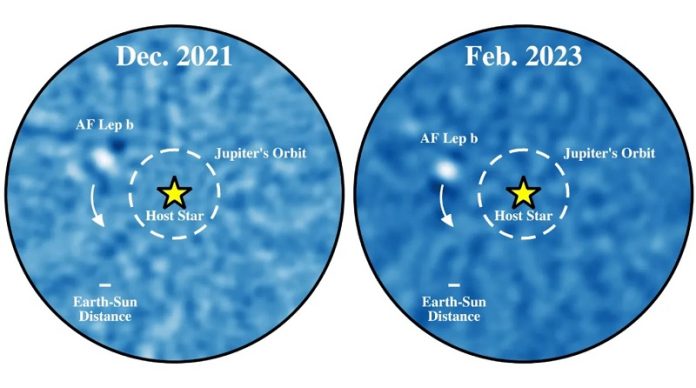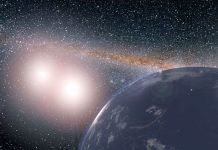
Jupiter has a ‘younger sibling’ residing 87.5 light years away, and for the first time, we’ve managed to snap a picture of it!
An extraordinary team of astronomers from The University of Texas at Austin has discovered an extrasolar planet (a planet outside of our solar system) that’s very much like the giant planets we’re familiar with, like Jupiter.
It’s special because it’s the smallest planet ever detected that not only has an orbit similar to our solar system’s giants but also has a known weight.
This impressive achievement has been made possible through a method called ‘astrometry’.
Kyle Franson, a graduate student in astronomy at UT Austin, explained that when they filtered out the star’s bright light while processing the observations, the planet became strikingly apparent.
The planet has been named AF Lep b and circles around a sun-like star, AF Leporis.
Astrometry is the secret behind this discovery.
It’s like playing detective, watching the slight wobble in a star’s position against other stars in the sky to guess if there might be a planet around it. It’s like looking at the movement of a parent holding a child’s hand – even if you can’t see the child, you can tell by the parent’s movement that they’re not alone.
This groundbreaking discovery, according to Brendan Bowler, assistant professor of astronomy at UT Austin, sets the stage for the use of astrometry as a tool for discovering new planets.
For the photography, the team used the W.M. Keck Observatory’s 10-meter telescope in Hawaii, equipped with some serious tech, including adaptive optics and a vector vortex coronagraph.
It’s the equivalent of having a superhuman zoom lens and a superpower to blot out the star’s glare to reveal the tiny, distant planet, which is a staggering 10,000 times fainter than its host star.
Capturing pictures of planets is no easy task. But with this new ‘dynamically informed’ approach, the team believes it can streamline the process, making it more efficient than previous methods.
Up until now, most extrasolar planets have been discovered either by observing the slight dimming of the star when a planet passes in front of it or by measuring tiny shifts in the star’s frequencies due to the planet’s gravitational pull.
Both techniques don’t actually let us see the planet. But the new method gives a direct image of the planet and allows astronomers to measure the planet’s mass, making it ideal for finding low-mass planets in wide orbits.
As for AF Lep b, more study is in the cards. Bowler mentions the forthcoming James Webb Space Telescope and the Giant Magellan Telescope as instrumental tools in further characterizing this young ‘sibling’ of Jupiter.
By further studying this newly discovered planet, astronomers hope to learn more about its physical properties and atmospheric chemistry.
Remarkably, two other teams also captured images of the same planet using the European Southern Observatory’s Very Large Telescope in Chile and shared their findings in the journal Astronomy & Astrophysics.
Clearly, AF Lep b is winning the popularity contest in the world of astronomy!



